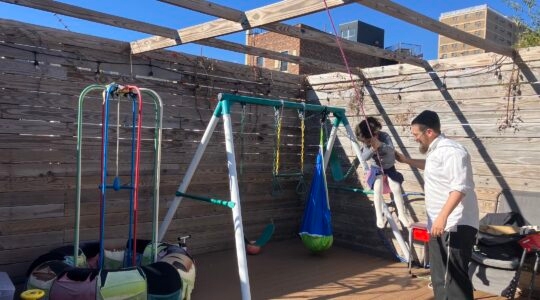I was sitting with a rabbinic friend swapping stories about our lives and our work. He started talking about an encounter he had recently had: “A Jewish man, probably in his early 30s, and his non-Jewish girlfriend came to speak with me. They want to marry, but his parents are dead-set against their only son marrying a gentile.
I asked the woman what she thought about the parents’ attitude, and she was honest. She said it seemed primitive and ridiculous. But she also said that, if necessary, she’d be willing to convert. After all, she wants to be a good person, and Judaism, she assumes, wants people to be good and might well have something to teach her about goodness. That’s how she put it, ‘might well have something to teach her about goodness.’”
“And what did you tell her?” I asked.
My friend, a rather traditional rabbi, answered: “I told her that we’re in no rush to bring people in, that conversion to Judaism is a not a quick business: ‘Presto, you’re a Jew.’ There’s a lot to study, a lot of rituals to learn, and I certainly can’t convert you before you do all that studying and commit yourself to practicing all that you study.”
“And what did she say to that?”
“It was the boyfriend who spoke up. He seemed really annoyed. ‘I told you this was pointless,’ he said to the girl, and then he turned to me. “We’re getting married in six weeks, Rabbi. With or without your help.”
My friend shrugged. “I told them that even if the two of them had come in with a more open attitude, six weeks was way too quick to do a conversion. Six months would be a stretch. They walked out with a book I gave them, but they’re not coming back, I can tell.”
My friend shook his head back and forth a few times, his expression a mixture of sadness and annoyance. “What I was really thinking was that they’d be better off going to City Hall, and just getting their license. We don’t need converts like that. One day, if she’s interested in becoming a real Jew, she can come see me.”
He shrugged his shoulders, and regarded my skeptical face. “I know, I know, that day’s never going to come.”
I was quiet a minute, thinking about, of all things, a 2,000-year-old Talmudic sage named Hillel, and about an American Jewish community that’s been getting smaller and smaller and whose members have now been intermarrying at rates of 40 percent for over 30 years. “What about that comment she made to you?” I finally asked him. He looked puzzled. “Which comment?” “That Judaism might well have something to teach her about being a good person.”
“Nice words,” he conceded. “But I would have been a little more encouraged if she had actually said something about religion. Like maybe she had read about Shabbat and wanted to observe it. Or was willing to keep kosher. At least then I would have felt that I had something to work with. But this couple gave me nothing to work with.”
Nothing to work with. His words reverberated in my head.
At the time, I had already begun thinking that I would like to write a book about Hillel, and this encounter only stiffened my resolve. For Hillel, I am convinced, would have found absolutely wrong-headed my friend’s all-too-common and reflexively discouraging approach to conversion. Just as I find it hard to imagine Hillel approving of the strange limbo in which 300,000 Russians of dubious Jewish—and sometimes non-Jewish—parentage are presently living in Israel, many of whom want to become Jews. I thought of Hillel because he is not only, arguably, Judaism’s greatest rabbinic sage, but also its most inclusive.
He is also the rabbinic figure most willing to give ethical behavior equal— even greater—weight, along with strict adherence to the ritual laws. The story for which Hillel is best known involves a non-Jew who is open to converting to Judaism but who wishes to learn about Judaism not in six weeks, but while “standing on one foot”—that is, in a single sound bite. Having literally been driven away with a stick by another rabbi who is affronted by his request, the non-Jew comes to Hillel, who is open to converting him, and who offers the man a single precept which mentions only the decent treatment of one’s fellow man—“That which is hateful to you, do not do to your fellow”—along with the admonition to keep studying. If there is an essence of Hillel, it is in this story in which he himself dares to offer an es- sence of Judaism.
Hillel, perhaps the greatest rabbi of the Talmud, lived some 1,200 years after Moses and about 900 after David, and presumably we should possess considerably more biographical information about him and his background than about theirs. But we don’t. A Talmudic passage refers to him as “Hillel the Babylonian,” from which we deduce that he was born in Babylon and subsequently came to Israel. The Talmud informs us that he went on to serve as Nasi, the foremost religious leader of the community.
Elsewhere, the Talmud traces his descent to King David, a touch of royalty that befits a man whose descendants would hold positions of religious leadership within the Jewish community for more than 400 years. However, we don’t know the names of his father or mother or, for that matter, his wife (though the rabbis tell a story that reveals her to have been a highly sensitive practitioner of charity). We know the name of one son, Shimon—we don’t know whether or not he had other children—and of his brother Shebna, who is identified as a merchant. And because of the leadership roles many of Hillel’s descendants assume, we know their names, among them, four Gamliels, two additional Shimons, three Yehudahs, and the final leader, known as Hillel the Second.
We also know of the contemporaneous rabbi, Shammai, founder of his own school—and the man who drove the would-be convert away—with whom Hillel and his disciples had numerous legal disputes; surprisingly, however, there is only one story in which the two men actually appear together (Shabbat 17a). Nevertheless, they are a famous emblematic pair of adversaries who each uphold principles essential to Jewish tradition.
We also know that Hillel was a disciple of two rabbis, Shmaya and Avtalion, who were the religious leaders of their age, and who were both descended from converts to Judaism. We know that Hillel assumed his position of leadership during a period of great instability and ignorance in Jewish life, in all likelihood related to the mega-maniacal kingship of Herod, who persecuted many of the era’s religious teachers. While the Talmud ascribes to Hillel a lifespan of 120 years (as was the case with Moses), it would seem that his years of religious leadership ranged from approximately 30 BCE to 10 CE, which would mean this book is being published, coincidentally, on what is possibly the 2,000th anniversary of his passing.
What we do possess about Hillel are stories: many, many stories. Stories scattered throughout the Talmud and Midrash, along with numerous legal rulings of his and of his disciples (Beit Hillel, the School of Hillel) that are recorded in the Mishnah, the Tosefta and both the Jerusalem and Babylonian editions of the Talmud. It is from these stories and rulings that Hillel enters the Jewish mind as so great a rabbinic sage, a man beloved for his legal daring, passion for learning, remarkable openness to con-verts and imaginative acts of kindness.
It is both in stories and in legal discussions that we encounter Hillel’s willingness to define—in one extended sentence, no less—Judaism’s essence, his openness to determining Jewish law not only on the basis of tradition but also on the basis of his keen understanding of the Torah’s intention, and his loving confidence in the instincts of the common man.
Yet, as much as Hillel’s teachings are familiar in the Jewish world and were repeatedly affirmed (by a heavenly voice no less) as valid and fundamental, many of his most important ideas have been ignored, sometimes profoundly so. Who was this man who can feel as radical today as he must have felt in his own time, and yet who sits, or ought to sit, squarely at the center of normative Judaism? And how have we moved so far from his vision?
Joseph Telushkin is the author of 16 books, including “Jewish Literacy,” “The book of Jewish Values ” and “ A Code of Jewish Ethics.” He is the rabbi of the Synagogue for the Performing Arts in Los Angeles and a senior associate of Clal: The National Jewish Center for Learning and Leadership. He lives in Manhattan.
This excerpt is taken from Joseph Telushkin’s book “Hillel: If Not Now, When?”—out this month as part of the Jewish Encounters book series from Nextbook Press/Schocken. Used by permission of Schocken Books, a division of Random House, Inc.
The New York Jewish Week brings you the stories behind the headlines, keeping you connected to Jewish life in New York. Help sustain the reporting you trust by donating today.




